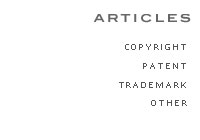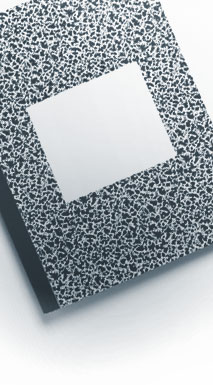

 |
||
 |
Fair Use Revisited PRINT Magazine Annual 1998 Frank J. Martinez, Esq. Every period has its symbols or icons that instantly communicate the look and feel of that particular time. More than anything else, the Internet is our of-the-moment symbol. The question for us is how to deal with and manage the Internet impact on culture, social institutions, and the law – the latter being the glue that holds it all together. Increasingly, the courts have been faced with cases that have forced them to consider the impact the Internet has on laws from an unwired age. The single biggest impact has been in the field of copyright. Rumors to the contrary, copyright is neither dead nor dying. It is merely adapting. Copyright law is founded on the constitutional principal that an artist or author should derive the benefits of his work by controlling the creation, publication, and dissemination of the work. The rights enumerated in the copyright statutes are the means by which those benefits are secured and protected. Here’s how the Constitution outlines the bargain. As an incentive to create, an artist or author receives a monopoly to his work for a limited period of time, after which the public receives the benefit of the work. Hence the term “public domain.” In one sense the Internet is irrelevant to any discussion of copyright, since it is the actions of people, not the medium they work in, that determine the outcome of copyright infringement suits. But the large issue the Internet has raised is whether the use of any copyrighted material on the Internet constitutes a fair use. The fair use exception in modern copyright law recognizes that exceptions to exclusive or monopoly rights often result in public benefit that far outweighs the rights of an author or artist without harming the value of the work. The fair use exception is one of the most litigated areas of copyright law. At the same time, fair use is one of the least understood defenses to a charge of copyright infringement, because the statute has no identified or “bright line” rules. Instead, the statute provides a series of tests that a court must examine and then weigh in favor of the copyright owner or the alleged infringer. A fair use of copyrighted work is generally one that is used for the purposes of criticism, comment, news reporting, teaching, scholarship, or research. When hearing a copyright infringement suit in which fair use has been raised as a defense, a court must examine the purpose and character of the use, including whether the use is commercial in nature or is for nonprofit educational purposes. The nature of the copyrighted work is examined, as well as the amount and substantiality of the copied portion as used in relation to the copyrighted work as a whole. Finally, the effect of the copying upon the potential market for or value of the copyrighted work is examined and is often considered to be the most important factor weighed by the court. The nature of the Internet makes the issue of fair use an everyday concern. All through the 1980s the courts placed new computer technology within the context of classic copyright law. Today, hardware and software copyright issues are well settled: We know whether the software code, menu structure, or the look and feel of a program are copyrightable. We are only now beginning to find out whether copying for digital sampling, fanzines, Webzines, or bulletin boards constitutes a fair use of copyrighted material. In Religious Technology Center v. Lerma, a federal court in Virginia was pointedly asked to consider whether information posted on the Internet required special treatment under copyright law. Lerma defended his posting of Church of Scientology material on the Internet as intended criticism, comment, news reporting, and scholarship—and therefore a fair use exception. In rejecting Lerma’s fair use defense, the court also explicitly considered the ephemeral nature of newsgroup postings. The court reasoned that if newsgroup postings contained unlicensed copyrighted work, it was the character of use – not the method of transmission – that determined whether their use was a fair use. In Sega Enterprises Ltd. V. Maphia, the federal district court in California determined that a bulletin board operator may not have direct liability for copyright infringement if his or her BBS receives unauthorized postings of copyrighted work. The court did find, however, that a BBS operator could be held as a contributory infringer if he had knowledge of the nature of the postings and actively facilitated or encouraged the unauthorized postings. In an earlier Sega case, Sega Enterprises Ltd. V. Accolade, the court found that the reverse engineering of software was a fair use, if the reverse engineering was used to create an entirely new program. Here, the court four that the fair use exception worked as it was intended. Accolade’s use of Sega’s copyrighted computer code facilitated an entirely new creative expression, which did not harm Sega’s market. Whether or not fanzines’ or Webzines’ use of copyrighted work is being considered a fair use is being resolved on a case-by-case basis. Because they are a relatively new phenomenon, the courts haven’t yet been involved to any great extent. However, the main issue raised in any case where fair use is offered as a defense will be the familiar one: Copyright is intended to protect the expressions take form in many media, the doctrine of fair use as it relates to the work of designers and artists also applies in more traditional media such as film and television. Lately, two producers have found that the fair use exception could not shield them against a charge of copyright infringement in instances where there was unauthorized use of an artist’s work in film and television. Traditionally, the use of an artist’s or designer’s work in these media was almost always considered a fair use of an otherwise protectable work. Recently, however, several cases were heard in the influential Second Circuit Court of Appeals in New York that may modify the longstanding notion that the minimal use of a designer’s or artist’s work in film or television is normally considered a fair use under copyright law. In one case, the artist Faith Ringgold brought a suit alleging that Black Entertainment Television’s use of a poster reproduction of her work Church Picnic was extensive enough to constitute a copyright infringement of her exclusive rights in the work – even though the original work is owned by High Museum of Art in Atlanta, which had a non-exclusive license to publish posters of the work. BET used Church Picnic during an episode of “Roc,” a sitcom depicting the lives of a middle-class African-American family. Ringgold’s case will probably have an impact on the copyright doctrine of fair use as it relates to the use of a designer’s or artist’s work in film, television, or new-media. In reviewing the facts of the case, the court examined the boundaries of the fair use defense as it relates to the use of artwork in television and helped clarify the definition of what constitutes a de minimis use of a copyrighted work. In addition, the court noted that a regulation established by the Library of Congress (the governing body for the Copyright Office) required the payment of a royalty for public broadcasts of published pictorial and visual works, whether used in a feature or as background display in television program. In pointing to a regulation directed to public broadcasting, the court noted that the Library of Congress had concluded that even a background use of a copyrighted work in a television program normally requires payment of a license fee. The court concluded that the regulation could reasonably be interpreted to apply with equal force to commercial broadcasters. Like many artists before her, Ringgold was faced with a two-pronged defense. Normally, if the use by another of a copyrighted work is de minimis, it is usually considered a fair use of the copyrighted work. In addition, since visual works of art are so different from film or television, it has traditionally been considered impossible for a movie or a film to erode or supplant the market for a visual work. Consequently, one of the most important tests n artist or designer must address in a copyright infringement case could almost never be proved using the traditional analysis applied to written works. In the Ringgold case, the court found that the use was not de minimis because the work appeared substantially complete in sequences throughout the television episode for a total of 26.75 seconds. In addition, the court found that use of the copyrighted work to decorate a set was so closely related to the reason the original work was created that BET’s use could not be considered a fair use within the normal context. The court noted that the use of Ringgold’s work to decorate the set for the television episode was not even remotely similar to any of the uses normally associated with a fair use. What makes this case particularly important for designers and artists is the court’s novel application of the Library of Congress “background license fee” provision. The court’s explicit recognition that works of art deserve greater protection when they are exploited in the television medium provides needed clarity to an important area of law. In a second case, Woods v. Universal Studios, Inc., the court awarded damages to a graphic designer whose work was the basis for one of the sets for the science-fiction film 12 Monkeys. Prior to an actual finding of damages for copyright infringement, however, the court issued an injunction against the showing of the film. Traditionally, such injunctions are almost never issued since any delay in the release of a film almost always results in a loss of revenue. Normally income lost as the result of an injunction is considered punitive in nature. The injunction is this case represents one of only a handful ever issued in the entire history of film in this country. The case is important from the perspective of defining the rights of a designer or artist because the court’s decision illustrates the copyright principle that copying a different medium can still be an infringement. Here, the producer of the movie used a set that was essentially a three-dimensional reproduction of a prior two-dimensional work by Lebbeus Woods. In this instance, the court noted that the movie producer’s use of the work was not “transformative” under copyright law and since the set designer for the film had no authorship rights in the underlying work, the set design could not be considered a permissible derivative work under copyright law. In addition, the court found that Universal Studios’ use was not an inconspicuous or background use of the artist’s work, which would have weighed in Universal’s favor. In order for a work to be considered transformative, the single most important factor is whether the new work will supplant the copyrighted work. Stated simply, the work will not be considered transformative if the new work is merely a copy or barely disguised copy. A transformative work is one where the creative portions contributed by an alleged infringer are such that a new work of art is created. This test cannot be reduced to mathematical pronouncements beyond the basic inquiry of the portion used in relation to the copyrighted work as a whole. These cases can be interpreted as broadening the rights of artists and designers since they identify factors that better determine when the use of a graphic work is or is not a fair use. However, the defense of fair use is always examined in light of particular facts of each case and there are no rules or guidelines for artists who use the work of others in some appropriative manner. In such cases, however, a court will look to the distinctive nature of each of the works, how much was copied in the creation of the new work, and the purpose of the new work, as well as the entire look, feel, or sound of the new work as compared to the original. The creative process is, in some ways, like the law. Artists and designers study and learn from the past. Each new work is judged on its own merits, and trusted concepts are adapted to new situations. Just as it is almost impossible to define a great work of art by category, the defense of fair use in copyright law also resists simple definitions.
Home Copyright Trademark Patent Litigation About Us ©2004 The Martinez Group PLLC |
 |